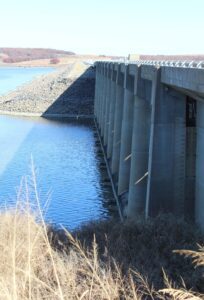 The Bartlesville Water Resources Committee met last week to discuss the status of ongoing efforts to combat drought conditions plaguing the area.
The Bartlesville Water Resources Committee met last week to discuss the status of ongoing efforts to combat drought conditions plaguing the area.
The drought has affected watershed areas, located in Southeast Kansas, for Hulah and Copan lakes, both of which serve as water sources for the City of Bartlesville and the surrounding region.
The WRC made recommendations in September aimed at moving the City closer to securing long-term water alternatives. During a meeting on Nov. 9, Water Utilities Director Terry Lauritsen gave the committee an update on those recommendations.
Reallocation of 10 million gallons of water per day (mgd) of flood control to water supply at Hulah Lake, the City’s primary water supply source.
On Nov. 6, the City Council approved an initiative to request planning assistance through the Planning Assistance to States program with the U.S. Army Corp of Engineers for the reallocation of water from flood control to water supply at Hulah and Copan Lake.
Staff made the request on Nov. 7. If accepted by USACOE, the Corps will update the study and look at reallocation of up to 10 percent of flood control to water supply at each lake, including environmental, cultural, real estate impacts and flood benefit losses.
Reallocating 5 percent would add 12,358 acre feet to the City’s existing 16,782 acre feet, increasing total storage to 29,130 acre feet. This would raise water levels by 3.75 feet, bringing the current conservation level of 733 feet to 736 feet. The cost for this option would be approximately $1.14 million ($92 per acre foot).
Reallocating 10 percent would add 24,695 acre feet, increasing total storage to 41,477 acre feet and raising water levels by 6.75 feet. This would bring the top of the conservation level to 739.74 feet. The estimated cost for this reallocation is $2.28 million.
Securing the remaining 2 mgd at Copan Lake through a possible partnership with the town of Copan, and reallocation of 10.5 mgd of flood control to water supply.
The cost to secure the remaining 2 mgd at Copan Lake could be anywhere from $500,000 to $5.25 million, but is likely not an option through the current legislation, Lauritsen said.
Reallocating 5 percent of flood control at Copan Lake would add 9,204 acre feet to available supply, increasing total storage from 34,646 acre feet to 32,850 acre feet. This would raise the top of the conservation pool by roughly 2 feet, from 710 feet to 711.97, and would cost an estimated $10.12 million in storage rights.
Reallocating to 10 percent would add 18,407 acre feet, increasing total storage to 53,053 and water levels by 4 feet. This would bring the top of the conservation pool to 713.74 feet and cost an estimated $20.24 million for storage rights.
Explore potential partnerships with other communities and tribes to reduce the cost of acquiring water rights at Kaw Lake, located in Kay County.
Lauritsen said City staff hopes to meet with Osage Nation representatives and other possible partners and/or communities soon. S2 Engineering will be tapped to update cost estimates for the pump station and pipeline that would be needed to access water at Kaw Lake. Progress on both fronts is expected by the end of the year.
Pursue a grant to further study the yield and sustainability for use of the Ada-Vamoosa Aquifer, located in Osage County.
Lauritsen told the committee the City will use Parkhill Engineering to determine requirements and costs for this study. That report should be completed by the end of this calendar year. He said Sen. James Lankford’s office is also investigating the next round of grants to complete the study, which will likely be mid-year 2024.
The committee is expected to meet again next month.
For more information, see Water 101: Guide to the City’s past, present and future water needs.

